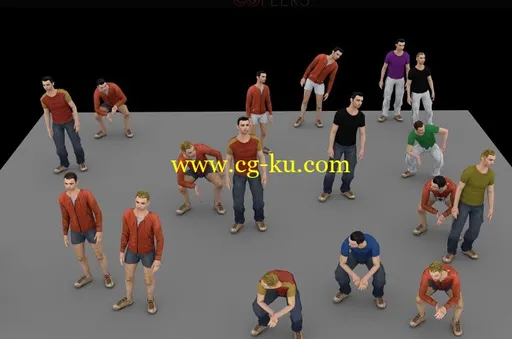
Title: FXPHD – GOL101 Introduction to Golaem Crowd
Info:
Golaem Crowd is an artist friendly crowd simulation tool for Maya used in production by a long and growing list of visual effect studios. With Golaem it’s easy to create diversity and apply behaviors to create natural looking crowds in a shorter time than has traditionally been possible. This introduction course assumes no previous knowledge of Golaem Crowd, but covers all aspects of the software and is based on direct production experience, so even existing users should find something new to learn.
After an overview of the software to give a sense of how the various tools work together, we’ll go through each element of Golaem Crowd in the order they’d be used to build a shot, from integrating custom Maya assets to crowd distribution, behaviors, simulation and rendering. While the course is pegged as introductory, it will quickly progress to cover more difficult subjects and more intermediate-level techniques.
Gareth Stevenson has been working as a 3D Generalist in London since switching over from the Videogame Industry, where he was at Microsoft. He’s worked on film projects including Hugo, Hunger Games and Star Trek: Into Darkness and TV series including Game of Thrones season 2 and 3. Most recently he’s been working with Golaem Crowd at Union Visual Effects in London, where he’s taken care of all 3D crowds on Davinci’s Demon’s Season 2, Stephen Frears’ Lance Armstrong Biopic and Suffragette.
Class 1: Overview and First Crowd Setup. We’ll touch on each of the main tools as we go through the process of setting up a basic spectator crowd, from an empty scene to render. You’ll get a feel for the overall crowd workflow and an understanding of how the different parts of Golaem work together.
Class 2: Character Maker – Skeleton Definition and Motion Conversion. We begin the conversion of Maya assets to custom Golaem Crowd formats by translating our Maya character skeleton into a Golaem Character Definition. We’ll look at some of the animation editing tools, output a Golaem animation file and learn how to translate animation from one skeleton to another. Finally we’ll take a look at a custom character set up for a crowd, a hybrid cyclist/bike skeleton.
Class 3: Character Definition and Asset Management. Continuing to set up our Maya assets, this week we’ll look at how we use character geometry and materials in the crowd. We’ll set up a custom character, learning how to switch between multiple pieces of geometry and materials on a single character type and some tricks we can use to create additional visual diversity.
Class 4: Entity Distribution/Placement. Now we have our crowd assets we can start to place them in an environment. We’ll look at various techniques that allow us to do this, from the standard population tool to the paint tool and generating particles from an image.
Class 5: Behavior Editor – Tools + Motion and Geometry Behaviors. In this class we’ll start to examine ways we can create behaviors for our crowd entities. We’ll learn about the nodes we can use to build behavior trees such as logic operators, containers and stop/start triggers. We’ll then take a look at the geometry behavior, demonstrating how to use a cached nCloth sim with our crowd.
Class 6: Behavior Editor – Character Locomotion. The locomotion behavior enables us to have walking crowd characters that use ground adaptation and dynamically switch animations. We’ll set up a walking crowd and spend some time with related elements including navmesh creation, obstacles, goto and navigation behaviors.
Class 7: Behavior Editor – Additional Behaviors. We’ll go through some additional behaviors and settings that can be used with our crowd characters, such as ‘constraint’, ‘formation’ and ‘look at’ behaviors. We’ll also take a look at the flocking behavior that can be used for groups of birds and other flying creatures.
Class 8: Simulation and Rendering. Taking a break from the behavior editor, we’ll go through the process of simulating and rendering our crowd. We’ll look at ways we can manipulate our sim to improve our final result and various settings that may be useful.
Class 9: Behavior Editor – Physics. Back into the Behavior Editor one last time to show how we can integrate ragdoll physics and forces with our crowd characters. We’ll set up a scene with guys falling over obstacles, falling over each other, rolling down a slope and getting thrown onto the ground by an explosion. We’ll see various techniques we can use to achieve effects like these and how to deal with the issues that arise.
Class 10: Production Tips and Tricks. We’ll look at some useful techniques across several areas of Golaem, including ways to iterate more quickly on your simulation, making global changes to all crowd fields, how to create greater visual diversity from just one texture, quickly editing animation files and how to set up avoidance for non-crowd animated elements in your scene.
标题 ︰ 数码 — — GOL101 Golaem 人群简介
信息 ︰
Golaem 人群是玛雅人在生产中使用的视觉效果工作室长期和日益增加的列表艺术家友好的人群仿真工具。与 Golaem 很容易创建多样性并应用在更短的时间,比传统的有可能创造自然看人群的行为。本介绍课程假定 Golaem 的人群,没有以前的知识,但涵盖所有方面的软件和基于直接生产经验,因此,即使现有的用户应该找到学习新的东西。
后的软件,让有各种工具如何协同工作的概述,我们会经过 Golaem Crowd 中,他们会使用打造一声枪响,从整合到人群分布、 行为、 模拟和渲染的自定义玛雅资产顺序的每个元素。虽然课程挂作为入门,它会很快进步涵盖更难学的课程和更多的中级技术。
加雷思 · 史蒂文森切换从视频游戏行业,他在那里在微软以来一直当在伦敦的 3D 通才。他在电影项目包括 Hugo,饥饿游戏 》 和星际迷航 》: 进黑暗和电视系列包括游戏的王座季节 2 和 3。最近他一直在联盟的视觉效果,在伦敦,在那里他照顾了达芬奇的恶魔季节 2、 弗里尔斯 Stephen 的兰斯 · 阿姆斯特朗传记片和妇女参政的所有 3D 人群 Golaem 人群。
1 班 ︰ 概述和首次人群设置。我们会对每个主要工具触摸,因为我们经历的设置基本观众人群,从空的场景呈现过程。你会获得整体人群工作流和理解 Golaem 的不同部分是如何一起工作的感觉。
第 2 类 ︰ 字符制造商 — — 骨架定义和运动转换。我们首先玛雅资产转为 Golaem人群的自定义格式将我们玛雅字符的骨架翻译成 Golaem 字符定义。我们会看一些动画编辑工具、 输出 Golaem 动画文件和学习如何翻译为另一种从一个骨骼动画。最后,我们将看看人群,混合动力自行车/自行车骨架为设置自定义字符。
3 类 ︰ 字符定义和资产管理。继续设置我们玛雅人资产,这周我们会看看我们如何使用字符的几何和材料在人群中。我们将设置一个自定义的角色,学习如何多件的几何形状和材料上的单个字符类型和一些技巧,我们可以使用来创建额外的视觉多样性之间进行切换。
4 班 ︰ 实体分布/安置。现在,我们有我们我们可以开始将它们放在环境中的人群资产。我们来看看各种技术,使我们能够做到这一点,从标准人口工具到油漆工具和从图像生成粒子。
第五类 ︰ 行为编辑器 — — 工具 + 运动和几何行为。这节课我们将开始审查方式我们可以为我们人群实体创建行为。我们会了解我们可以使用来构建逻辑算子、 容器和停止/启动触发器等行为树的节点。我们会然后看看几何图形行为,展示如何使用缓存的 nCloth sim 卡与我们的人群。
6 班 ︰ 行为编辑器 — — 字符运动。运动行为使我们有走人群的字符,使用地面适应动态切换动画。我们建立了步行的人群,花费一些时间与相关元素包括 navmesh创作、 障碍、 goto 和导航行为。
第 7 类 ︰ 行为编辑器 — — 附加行为。我们会经过一些额外的行为和可以用我国人群的特征,如 '约束'、 '形成' 和 '看看' 行为的设置。我们也会看看可以用于鸟类和其他飞行的生物群体的植绒行为。
8 班 ︰ 模拟和渲染。从行为编辑器正在休息,我们就去通过模拟和渲染我们人群的过程。我们会看的方法我们可以操纵我们的 sim 卡,以提高我们的最终结果和可能有用的各种设置。
9 班 ︰ 行为编辑器 — — 物理。最后一次回到到行为编辑器显示我们如何把布娃娃物理和部队与我们人群字符。我们会跟男人落过障碍,摔倒对方,滚下斜坡和获得扔在地上爆炸设置的场景。我们会看到我们可以用来实现这些、 如何处理出现的问题等影响的各种技术。
10 班 ︰ 生产的提示和技巧。几个领域的 Golaem,包括如何更快地进行迭代模拟,进行全局更改到人群中的所有字段,如何打造更大的视觉多样性从只是一个纹理,快速编辑动画文件和如何设置为非人群避免动画元素在你的场景中,我们来看一些有用的技巧。